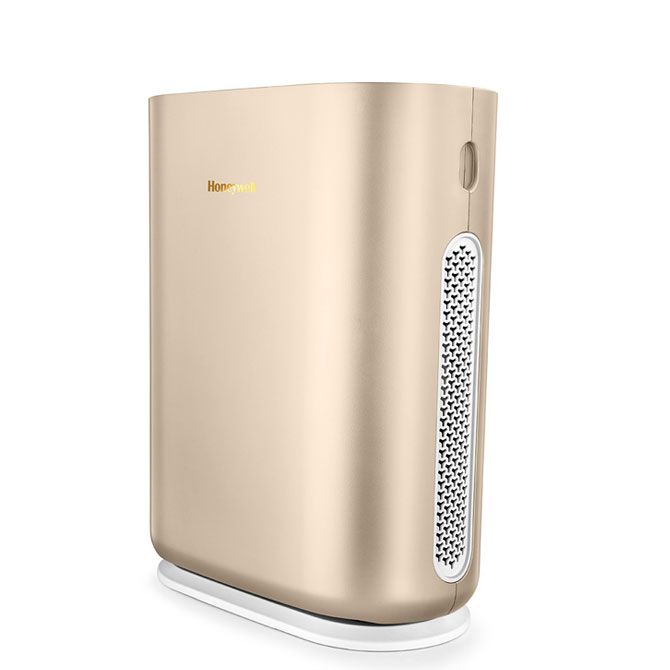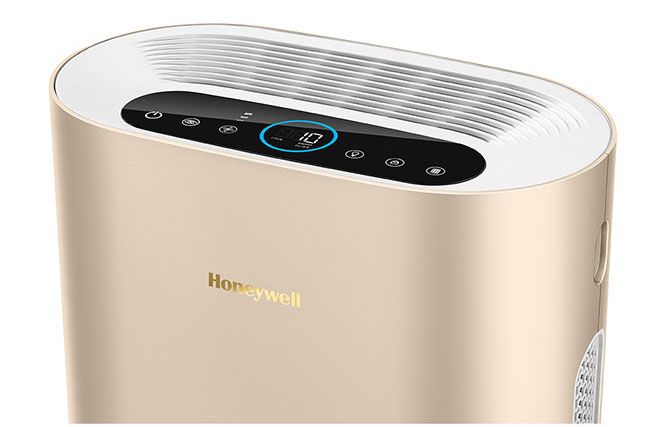 | « Back to article | Print this article |
Given the rising levels of pollution, air purifiers have now become a necessity. Manavi Kapur and Veer Arjun Singh check out some of the options in the market.

As pollution levels peak in winter, staying indoors might appear to be a healthier option. But what many people don't know is that indoor air quality is, at times, worse than the air outside.
And even if it's comparable to the outside levels, it's still alarmingly high, according to the World Health Organization.
This makes air purifiers a necessity.
We test a few to see if they make our homes any healthier for our lungs.
Samsung AX5500
When the Samsung AX5500 air purifier was delivered to my home, my father wondered if I had lost my marbles and bought another one for my room.
But his interest was piqued given how this machine made the other air purifiers in our home look like Lilliputians.

Once I managed to hurl it out of the box, setting it up was a breeze.
A standard netted pre-filter opens up to reveal the two-in-one carbon and HEPA filter.
Once you remove the packaging from the filter and hit the reset button, it's good to go.
The wheels are a godsend for a model this large.

As soon as I switched it on, the PM 2.5 level as indicated on the purifier came rapidly down from 50 to a mere nine, making me think that the AX5500 was probably malfunctioning.
I opened the balcony door for about 15 minutes to test the indicator and the PM 2.5 shot up to 100.
It took the AX5500 15 minutes to bring it back to nine for a small bedroom.
This is probably because it is meant to service 60 sq metre (or 645 sq ft; the size of a large living room).
For a machine its size, the fan is quiet and effective; quieter still in sleep mode.
No purifier that I own -- Mi 2S, H3O and Philips AC1215/20 -- has been able to bring PM 2.5 levels down to a 'healthy' level without having the fan go berserk.
The virus doctor functionality is also supposed to disinfect the air, but I had no device to independently test its efficacy.

Samsung claims its air purifier delivers visibly clean air.
The real quantifiable change is in the PM-level indicator.
However, I had no way of testing its reading to be true, though a closed bedroom did feel less stuffy (unlike with smaller air purifiers).
The AX5500 is considerably expensive at Rs 34,999.
Samsung recommends replacing the filter every six months if the air purifier is used 24 hours a day.
But considering how most small air purifiers are useless for Delhi's unimaginably toxic air and are unable to bring the PM 2.5 level below 20 even on their own gauges, this seems like a good single investment rather than buying multiple smaller ones.

Honeywell Air Touch i9
The Honeywell Air Touch i9 meets the prerequisites of a good air filter.
It has a pre-filter for cleaning the air of large particulate matter such as PM 10 and a HEPA filter to bring down the levels of PM 2.5 and other particulate matter of up to 0.3 microns in size.
It's a standard composition that every air purifier should have.
What Honeywell i9 does extra is that it also absorbs smoke and toxic gasses, while eliminating the odour from organic compounds with its patented HiSi filter.
The device is fit for a standard room (415 sq ft) and its effects are measurable.
The most likeable feature of this unit is its panel on top.
It operates with a light touch and is simple to understand.
Though recommended, you'll hardly need to go through the user manual.
The touch panel has a PM 2.5 indicator, three modes for adjusting the fan speed, a night mode to turn the panel light off and a power button.
The review unit I tested was champagne gold. The colour goes with most interiors, while adding a bit of character to the room.
It is seamlessly cylindrical and has the appeal of a quality gadget.

The i9 has a clean air delivery rate (CADR) of 300 cu m/hr, which is desirable but not exceptional.
In practice, it was successful in bringing down the PM 2.5 levels from around 250 to below 150 (indicator turns from red to amber) in under two hours when the doors and windows were kept shut.
The night mode turns the panel light off and the fan speed to minimum.
I let it run at that for over eight hours and the PM 2.5 level was down to below 75 (indicator light turns blue).
The number did not dip further, but anything around 50 is quite safe -- it's suburban Canada levels.
The peak power consumption, however, is a little about standard at 42W.

For Rs 18,900 (on Amazon), it's one of the better looking air purifiers and is mighty effective in a small bedroom.
Its three-layer composite filter is good for six months to one year (3,000 hours) depending on the pollution levels and can be easily replaced at home (costs approximately Rs 4,290).
The panel will light up when it's time.

Panasonic F-PXM55AAD
The Panasonic F-PXM55AAD is built like a robot.
The compact unit fits in almost any corner.
But the unibody design with its unexpected bends does not make it remarkably appealing.
Placing the air vents at the top, however, is a practical design choice for small spaces.
This air purifier ticks the boxes on paper with a HEPA and a de-odourising filter, but measuring its effectiveness is a bit of a challenge owing to the lack of a PM 2.5 indicator.
One has to rely on its LED light strip at the front top -- red for bad and blue for safe -- to broadly measure the air quality.
While the company says the unit is good for a 452 sq ft room, in my experience, the Japanese technology backing this device falls slightly short in Indian homes.

I first switched it on in test conditions -- behind closed doors in an almost sealed room.
The panel has a PM 2.5 cleaning mode, which basically means you let the fan run amok till PM levels are brought down to safe.
In theory, it should switch to the quieter Econavi mode as soon as it achieves this goal.
Well, that did not happen.
I had to manually change the mode to sleep in peace.
Eight hours later, the red light was still red.
I had to plug in another air purifier to satisfy my curiosity.
The PM2 .5 levels were down to 120 from 345.
It was comforting to know that the company's Nanoe technology works.
It's just not fast enough.

After a few exits and back, the air outside the room felt noticeably stuffy and smelled of something I couldn't place.
The unit's odour filter seemed to have done its job, too.
At a peak power usage of 11W, it's also very energy-efficient.
Still, the PM 2.5 cleaning mode that unleashes a loud fan with nothing to quantify the PM levels makes for an underwhelming experience.
The company claims its filter life is 10 years, which is unrealistic in present conditions, and the cost of replacing the filter at Rs 5,900 is high.
Selling for Rs 20,765 on Amazon, Panasonic F-PXM55AAD has better alternatives out there.

*Image used for representational purposes only.